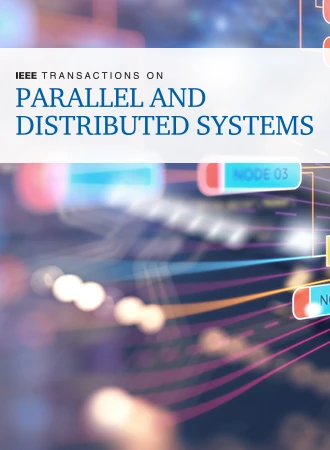PeakFS: An Ultra-High Performance Parallel File System via Computing-Network-Storage Co-Optimization for HPC Applications
IF 5.6
2区 计算机科学
Q1 COMPUTER SCIENCE, THEORY & METHODS
IEEE Transactions on Parallel and Distributed Systems
Pub Date : 2024-10-24
DOI:10.1109/TPDS.2024.3485754
引用次数: 0
Abstract
Emerging high-performance computing (HPC) applications with diverse workload characteristics impose greater demands on parallel file systems (PFSs). PFSs also require more efficient software designs to fully utilize the performance of modern hardware, such as multi-core CPUs, Remote Direct Memory Access (RDMA), and NVMe SSDs. However, existing PFSs expose great limitations under these requirements due to limited multi-core scalability, unaware of HPC workloads, and disjointed network-storage optimizations. In this article, we present PeakFS, an ultra-high performance parallel file system via computing-network-storage co-optimization for HPC applications. PeakFS designs a shared-nothing scheduling system based on link-reduced task dispatching with lock-free queues to reduce concurrency overhead. Besides, PeakFS improves I/O performance with flexible distribution strategies, memory-efficient indexing, and metadata caching according to HPC I/O characteristics. Finally, PeakFS shortens the critical path of request processing through network-storage co-optimizations. Experimental results show that the metadata and data performance of PeakFS reaches more than 90% of the hardware limits. For metadata throughput, PeakFS achieves a 3.5–19× improvement over GekkoFS and outperforms BeeGFS by three orders of magnitude.PeakFS:通过计算-网络-存储协同优化实现高性能计算应用的超高性能并行文件系统
新兴的高性能计算(HPC)应用具有多样化的工作负载特征,对并行文件系统(PFS)提出了更高的要求。并行文件系统还需要更高效的软件设计,以充分利用多核 CPU、远程直接内存访问(RDMA)和 NVMe SSD 等现代硬件的性能。然而,由于多核可扩展性有限、不了解 HPC 工作负载以及网络-存储优化脱节,现有的 PFS 在这些要求下暴露出很大的局限性。在这篇文章中,我们介绍了PeakFS,一个通过计算-网络-存储协同优化实现高性能计算应用的超高性能并行文件系统。PeakFS 设计了一个基于链路减少的任务调度和无锁队列的无共享调度系统,以减少并发开销。此外,PeakFS 还根据 HPC I/O 特性,通过灵活的分配策略、内存高效索引和元数据缓存来提高 I/O 性能。最后,PeakFS通过网络-存储协同优化缩短了请求处理的关键路径。实验结果表明,PeakFS的元数据和数据性能达到硬件极限的90%以上。在元数据吞吐量方面,PeakFS 比 GekkoFS 提高了 3.5-19 倍,比 BeeGFS 高出三个数量级。
本文章由计算机程序翻译,如有差异,请以英文原文为准。
求助全文
约1分钟内获得全文
求助全文
来源期刊

IEEE Transactions on Parallel and Distributed Systems
工程技术-工程:电子与电气
CiteScore
11.00
自引率
9.40%
发文量
281
审稿时长
5.6 months
期刊介绍:
IEEE Transactions on Parallel and Distributed Systems (TPDS) is published monthly. It publishes a range of papers, comments on previously published papers, and survey articles that deal with the parallel and distributed systems research areas of current importance to our readers. Particular areas of interest include, but are not limited to:
a) Parallel and distributed algorithms, focusing on topics such as: models of computation; numerical, combinatorial, and data-intensive parallel algorithms, scalability of algorithms and data structures for parallel and distributed systems, communication and synchronization protocols, network algorithms, scheduling, and load balancing.
b) Applications of parallel and distributed computing, including computational and data-enabled science and engineering, big data applications, parallel crowd sourcing, large-scale social network analysis, management of big data, cloud and grid computing, scientific and biomedical applications, mobile computing, and cyber-physical systems.
c) Parallel and distributed architectures, including architectures for instruction-level and thread-level parallelism; design, analysis, implementation, fault resilience and performance measurements of multiple-processor systems; multicore processors, heterogeneous many-core systems; petascale and exascale systems designs; novel big data architectures; special purpose architectures, including graphics processors, signal processors, network processors, media accelerators, and other special purpose processors and accelerators; impact of technology on architecture; network and interconnect architectures; parallel I/O and storage systems; architecture of the memory hierarchy; power-efficient and green computing architectures; dependable architectures; and performance modeling and evaluation.
d) Parallel and distributed software, including parallel and multicore programming languages and compilers, runtime systems, operating systems, Internet computing and web services, resource management including green computing, middleware for grids, clouds, and data centers, libraries, performance modeling and evaluation, parallel programming paradigms, and programming environments and tools.
 求助内容:
求助内容: 应助结果提醒方式:
应助结果提醒方式:


